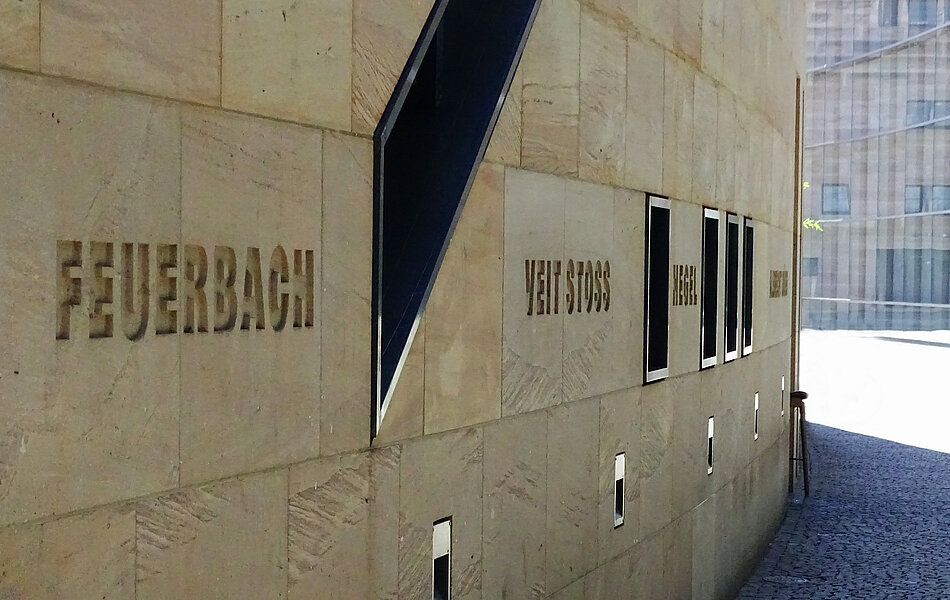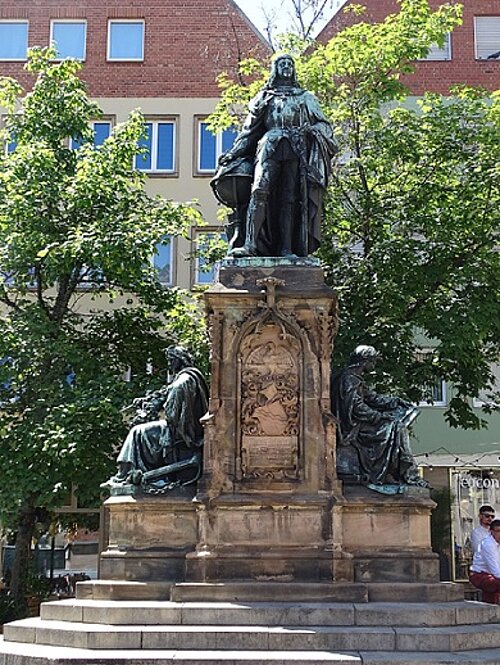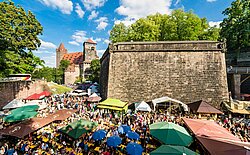
Take your time to deepen the subject of the walk by visiting the Museums like the Albrecht Dürer's House andthe national germanistic museum.
1As a starting point of our tour we pick the Klarissenplatz, the square right behind hotel Victoria. At the end of the glass facade of the Neues Museum, towards Luitpoldstrasse, there are several names carved into the stone wall: HANS SACHS – FEUERBACH – VEIT STOSS – HEGEL – ALBRECHT DÜRER. All five of these humanists are closely connected with the city of Nuremberg. We will meet some of them again in the course of this walk.
2In the courtyard of the city library, which we reach by crossing Peter-Vischer-Strasse, we find another great son of Nuremberg. The city honoured Hermann Kesten with an inconspicuous sculpture. The writer was, together with Erich Kästner, Kurt Tucholsky and Bertold Brecht, one of the great representatives of the New Objectivity in literature. In 1980 he became an honorary citizen of Nuremberg.
3We cross the river Pegnitz and walk to the island Schütt and from there into the inner courtyard of the Heilig Geist Spital. Here we find the table tomb of Konrad Groß. The building of Heilig Geist Spital and the institution were both a generous donation by Konrad Groß in the years 1331/39. Konrad was a member of the patrician family Groß and was known as one of the richest men of his time.
At the corner between Museumsbrücke bridge and Spitalgasse, looking upon you is another monument of Konrad Groß. Next to him, the famous foundation certificate can be found on the wall of the building.
4Only a few steps further we meet another great son of Nuremberg, Hans Sachs, who is recognized by the name of a square as well as a monument in the city. Hans Sachs is one of the most known German poets of the 16th century, whose fame is mainly based on the implementation of Martin Luther’s teachings (Die Wittenbergische Nachtigall – The Nightingale of Wittenberg).
5Let us continue our way to the Theresienplatz, where we can see the memorial of Martin Behaim. It honours the man who created the oldest preserved globe. This globe (1492-94) shows us that this well-educated humanist knew of the world as it really is so early on.
6Across the street, at Egidienplatz, to the right of the church of St. Egidien, we can find the sandstone sculpture of Philipp Melanchton, a true representation of an ideal renaissance scholar, wearing the traditional robes. Melanchton is well known by being one of Martin Luther’s closest associates and deeply influenced the emerging church and school system. He was the first to fund a type of school, which then later became the actual version of the German Gymnasium (an academic high school in several central European countries).
7Next, we search for, most likely, best known historical personality of the city, who even lent his name to an era: Dürerzeit, Dürer-time. To admire this next monument, we stroll north to Albrecht-Dürer-Platz. Even from a distance we can already see the tall memorial dominating the square. It shows Albrecht Dürer as he saw and portrayed himself, confidently looking upon the world as a: painter, graphic designer, mathematician and art historian. He got famous even beyond Germany; being recognized as a foreign artist in Italy was an enormous achievement at the time.
8In the street bearing the artist's name, that can be reached by passing through Agnesgasse, that is branching off Albrecht-Dürer-Platz, we search for a house number 17. Here we find a plaque commemorating the goldsmith and art theorist Wenzel Jamnitzer. He was one of the most significant goldsmiths in Germany, who made his crafts in the Mannerism style.
9At Maxplatz, we find another memorial which shows yet another great humanist of the city of Nuremberg, apart from Albrecht Dürer: Willibald Pirckheimer.
10Right in front of Maxbrücke bridge, one can see the Dürer-Pirckheimer-Fountain which celebrates the friendship between the two Renaissance men, who exchanged ideas and thoughts throughout their entire lives. In addition to Dürer, Willibald Pirckheimer was in contact with Beatus Rhenanus, Erasmus of Rotterdam, Thomas Morus and many more influential contemporaries.

Impressions
Further information
Approximat walking time: 4h
 Neue Infos für Ihren Urlaub – folgen Sie uns auf Instagram
Neue Infos für Ihren Urlaub – folgen Sie uns auf Instagram





